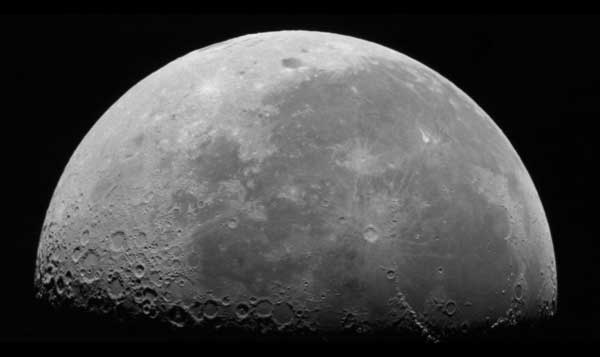
At one point during the Apollo 17 mission, moonwalking astronauts Gene Cernan and Harrison "Jack" Schmitt tried to drive their lunar rover up the face of a 200-foot-high rise known as the Lincoln-Lee Scarp. It didn't seem that imposing a task, but the rover's wheels slipped so much that the astronauts were forced to climb it at an angle, much as a sailboat tacks into a stiff wind.

Thrust fault diagram
Thrust faults occur when the lunar crust is compressed laterally, breaking the rocky materials below and forming a long scarp on the surface.
Lincoln-Lee is the kind of feature created when one slab of rock overrides another due to horizontal compression (what geologists term a thrust fault). On Earth, good (if enormous) examples of thrust faults occur where crustal plates collide — think how the towering Andes rim the west coast of South America, and you get the idea.
What Cernan and Schmitt couldn't have known back in 1972 is that Lincoln-Lee is not an isolated feature but one of likely hundreds of small thrust faults all over the Moon. That revelation came to light only recently, thanks to the incredibly detailed images of the lunar surface being beamed to Earth by two Narrow Angle Cameras aboard NASA's Lunar Reconnaissance Orbiter. (These same cameras have taken snapshots of the historic Apollo 11 landing site and others.)

Map of lunar scarps
The distribution of lobate scarps known as of mid-2010. Black dots indicate previously known features, while white dots mark those found in images by the Lunar Reconnaissance Orbiter. Click here for a larger version.
It wasn't until LRO arrived on the scene that geologists realized the subtle fractures are pervasive. After poring over images from LRO, a team led by Thomas Watters (Smithsonian Institution) has identified 14 new scarps in addition to the three dozen already known. As the map here shows, half of the new finds are poleward of 60° in latitude. (Most of the previously recognized scarps had been spotted by cameras mounted into the orbiting command modules of Apollos 15, 16, and 17 — but these craft never strayed far from the lunar equator.)
In the August 20th issue of Science, the researchers reach a startling and unexpected conclusion: "We have now found that these lobate scarps occur everywhere on the Moon," Watters explains, "which means the Moon has been contracting or shrinking globally."

Scarp in Gregory crater
A thrust fault crossing the floor of Gregory crater on the lunar farside.
All told, the lunar diameter hasn't changed much, probably only about 700 feet (200 m). But the scarps look so fresh that they must have formed in the recent past, geologically speaking. "These scarps can't be any older than 800 million to 1 billion years," Watters noted during a press briefing yesterday, and they could be much younger. "We're finding the Moon is a truly dynamic planet," adds Michael Wargo, chief lunar scientist at NASA headquarters. "Who'd have thought that tectonic processes would still be occurring today?"
The scarps escaped notice until now because they're only a mile or two long and just tens of feet high — completely invisible to backyard telescopes and even to previous lunar-orbiting craft. Most likely, they result from the gradual contraction of the lunar interior as it cools, a process that apparently didn't end when the last maria filled with lava some 3 billion years ago.
Thrust faults appear on the surfaces of Mars and especially Mercury, but they're huge by comparison. Some of the Mercurian scars are hundreds of miles long and more than a mile high, implying that the planet shrank by at least a couple of miles as its molten interior cooled and contracted.
Yet at one time the Moon must have been really, really hot as well. After all, it likely accreted by picking up the white-hot pieces after something enormous collided early on with Earth. So shouldn't there likewise be giant thrust faults jutting skyward across lunar landscape? Some researchers think the Moon did undergo substantial contraction, but the surface scars from that have been erased over time. Watters thinks otherwise. "Our results are really more consistent with a cooler initial starting temperature," he explains, "one that didn't allow the entire Moon to melt."

Astronaut collecting lunar soil
Astronaut Harrison "Jack" Schmitt uses a special rake to collect lunar soil during the Apollo 17 mission in December 1972.
As I listened to yesterday's press briefing, I wondered what Cernan and Schmitt were thinking as they struggled up the slope of Lincoln-Lee Scarp all those years ago. So I asked one of them.
"We were well aware of the Lee-Lincoln scarp and that it is a potential thrust fault or wrinkle ridge," Schmitt recalls. "We drove up it to Station 2 at the base of the South Massif, and along and down it going to Station 4 [Shorty crater]. It was entirely covered by a light mantle or avalanche deposit. The avalanche probably flowed off the South Massif about 100 million years ago, as it appears to have been triggered by [nearby impacts from] Tycho ejecta. Lee-Lincoln would be at least older than the avalanche and I suspect much older than that."
Watters and other lunar geologists should eventually be able to say more about how and when all these lobate scarps formed. As of now, LRO has mapped only about 10% of the lunar surface at high resolution. But give it another three years (assuming the funding holds out), and there'll be enough coverage to inspect the entire lunar glove down to a resolution of just a few feet.

No comments:
Post a Comment